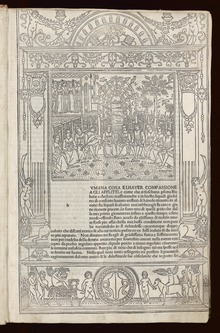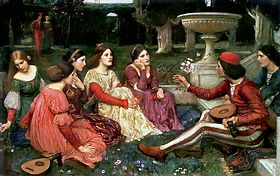The British Museum explains that December's name comes from the Latin word "decem," meaning ten, because it was the tenth month in the ancient Roman calendar. The calendar was later modified to include January and February, but December kept its original name. - Latin root: The name "December" comes from "decem," the Latin word for "ten".
- Latin root: The name "December" comes from "decem," the Latin word for "ten".
十日談
-----林皎碧うぐひすの 啼や師走の 羅生門~與謝蕪村
往昔日本人稱陰曆12月為「師走(しわす)」,文明開化後則指陽曆12月。「師」指僧侶、和尚;「走す」為古語,奔波之意。也就是說年關一到,僧侶為誦經、作法事東奔西跑,非常忙碌,才有「師走」為12月的別稱。現代社會一到年底,不僅和尚在忙,百工百業恐怕都得“摳摳踵”、四處奔波吧?・・原本師走不師走,和我這個餘生都是休假的人毫無關係。對我來說,2025年是艱難的一年,還好有弟弟妹妹,無論如何總能克服困難,進入12月就剩最後一段路,我也要啟動師走模式的忙碌,把該做的事都做好,更期盼如與謝蕪村這首俳句所揭示,艱難中見希望!
「うぐひすの」は、多くの場合、「うぐいす」に関連する言葉の連なりを指します。具体的には、有名な俳句「うぐひすの 谷よりいづる 声」(大伴家持)のように、ウグイスの鳴き声を表す言葉として使われます。また、春を代表する鳥であり、**「春告鳥」**とも呼ばれることにも関連しています。 「うぐひすの」が使われる文脈- 俳句における慣用的な表現:
- 「うぐひすの 声」、「うぐひすの 谷」、「うぐひすの 梅」など、詩的な表現の一部として用いられることが多いです。
- 例:「うぐひすの 声ほのかに して」
- 「春告鳥」としての連想:
- ウグイスが早春に鳴き始めることから、春の訪れを知らせる鳥として「うぐひすの 知らせ」のように表現されることもあります。
補足- ウグイス: 日本の春を象徴する小鳥の一種です。
- 季語: 俳句では春の季語であり、特に「三春」として扱われます。
- 表記: 「鶯」という漢字の他に、古くは「宇具比須」とも書かれました。
- 俳句における慣用的な表現:
- 「うぐひすの 声」、「うぐひすの 谷」、「うぐひすの 梅」など、詩的な表現の一部として用いられることが多いです。
- 例:「うぐひすの 声ほのかに して」
- 「春告鳥」としての連想:
- ウグイスが早春に鳴き始めることから、春の訪れを知らせる鳥として「うぐひすの 知らせ」のように表現されることもあります。
- ウグイス: 日本の春を象徴する小鳥の一種です。
- 季語: 俳句では春の季語であり、特に「三春」として扱われます。
- 表記: 「鶯」という漢字の他に、古くは「宇具比須」とも書かれました。
沒保握的漢譯 人工智慧概述
「鶯鳴」(Uguisuno)通常指與日本柳鶯(uguisu)相關的字。具體來說,它用來描述柳鶯的鳴叫,例如著名的俳句《柳鶯的鳴聲從山谷升起》(Otomo no Yakamochi)。它也與柳鶯象徵春天的寓意以及其別名“報春鳥”有關。
「鶯鳴」(Uguisuno)的使用情境
俳句中的慣用語:它常用於詩歌表達中,例如“柳鶯的鳴聲”、“柳鶯的山谷”和“柳鶯的梅花”。
例:“柳鶯的鳴聲微弱。”
象徵春天的鳥:由於鶯在早春開始鳴叫,有時被比作預示春天到來的鳥,例如“鶯的消息”。
補充訊息
鶯:一種在日本像徵春天的小型鳥類。
季節詞:在俳句中,它是一個與春天相關的詞,特別常被寫成「三春」。
拼法:除了漢字「鶯」(uguisu)之外,過去也曾寫作「鶯鶯」(ugubisu)。
邱振瑞
我與北大路魯山人都愛吃田螺眾所周知,北大路魯山人是個奇人,他能寫能畫善於陶藝,而且還是品鑑美食的高手,他寫了很多美食隨筆,讀者從文章中皆能感受到日本鄉村風味餐中的季節感。以我過往的閱讀經驗裡,他的隨筆〈田螺〉內容生動有趣,並激發了我少年時期吃田螺的經驗。北大路魯山人〈田螺〉這樣寫道:近日,田間傳來時而喧鬧時而急促的鳴響,那聲音很清晰。有人斷言那是田螺的叫聲,但對認識得田螺鳴聲的人卻嗤之以鼻:「那分明是蛙鳴」如此反駁。這般爭論年年重演,每逢時節便日日上演。若有人質疑這種說法,就提議將田螺放入壺中於室內聽其真假,然而,世上沒有閒得發慌至此的怪人吧?話雖如此,詩人與謝蕪村有這首俳句:豎耳細聽之 桶中有田螺鳴叫如此看來,與謝蕪村究竟是傾聽著未經烹煮的田螺在桶中鳴叫,抑或特意將田螺置入桶中聆聽?縱然如此,田螺之聲抑或蛙鳴之謎終究未解,總被都市人置之不理。不過,不論是田螺在叫或蛙鳴都無關宏旨,更重要的是,這田螺可是令人垂涎的好東西。正因眾人知道田間遍布田螺,便有先入為主認為它不是珍饈而加以輕視。相反,它卻是食客們珍愛的佳餚。每當田螺突然現身於料理前菜之時,我們總會不自覺地感到親切,嘴角不禁上揚。(在日本)普遍的做法是將田螺(肉)切碎燉煮,無論在何處品嚐皆屬尋常的滋味。但在出雲(島根縣東部)地區,人們會加入酒粕同煮——此乃大分料理的獨創技法,既合理又極為上乘。
WWWW
發光小鱼
在備課時,看見與謝蕪村所畫《蕪村妖怪繪卷》裡的「化貓」,寫著「貓夜復一夜的出來跳舞(夜な夜な貓またあまた出ておどりける)」,正與桌邊的俳句選集相映對。
如夢似幻──
輕捏著
一隻蝴蝶 (205)
與謝蕪村(1716-1783)是誰呢?他被稱為是與與松尾芭蕉齊名的俳句大師,是日本古典俳壇三大家之一,他出生於普通人家,年輕時就對繪畫很有興趣,並且得到「狩野派」畫家的指點;之後於江戶投身俳句流派「夜半亭」創始人早野巴人(師承芭蕉弟子寶井其角)門下,得到了棲身之所與心靈歸處。蕪村此俳號出自於陶淵明《歸去來辭》:「歸去來兮,田園將蕪胡不歸」,二十五至四十五歲之間,多以畫為主,但也學漢詩,寫俳句。
然其一生終究是詩畫雙絕,「俳中有畫,畫中有詩」,句中充滿了色彩與畫面,風格浪漫,詩意鮮活,與芭蕉的寂、雅、幽玄、消極不同的是,蕪村文字充滿了明亮、美麗,也多寫春夏之景。在他的句子之中,充滿了鮮明的形像與動態感,好像在月光下,貓和杓子都真的跳起舞來:
月夜將盡──
貓啊、杓子啊......大家
一起來跳舞 (152)
這裡運用了日本成語中的「猫も杓子も」,有大家一起來跳舞之意,但放在月光之下,卻更顯奇異,好像貓咪與杓子(付喪神之屬)真的會跳起舞來。另外我也很喜愛這宛如森林精靈玩耍的場景:
狐狸嬉遊於
水仙花叢間──
新月淡照之夜 (266)
讀起來好像凱爾特女神隨時會降臨,這也是蕪村作品中的一大特色,跳出了一定的氛圍而有自己的色彩。寫月光的流轉:
月光
西移,花影
東行 (305)
則有些蘇軾「轉朱閣、低綺戶,照無眠」之意,在靜態的畫面之中,月光成為了動態的存在,也代表了時間的流動。
正如同陳黎、張芬齡所說:「學者頗喜對比松尾芭蕉和與謝蕪村的不同:芭蕉是探索者,蕪村是藝術家;芭蕉是苦行詩人,蕪村是入世畫家;芭蕉是表達自身經歷的主觀的詩人,蕪村是藝術與創作優先的客觀的詩人;芭蕉的藝術特色是古雅、幽玄、平靜、素樸,蕪村則是在古典中尋找鮮活的詩趣;芭蕉抒發真實生活中所見、所聞、所感,自然與人生於他是合為一體的,蕪村則往往跳脫寫實,以充沛的想像力創造具藝術感和新鮮感的詩意。」我在與謝蕪村的俳句中可以讀到四時景物的變幻,例如:
冬日枯樹林前的
鴛鴦──
盡美矣 (011)
家家燈
火影,映現
雪屋中 (078)
這兩首讓人感受到冬日的寧靜之美,但靜態與雪白之中,又有毛色絕美的鴛鴦依偎,以及溫暖昏黃的燈火點綴,雖冬日苦寒,卻又有了溫情。俳句就像是三兩筆的簡筆繪,但完全勾勒出感受核心。
其作品之中又有與景物相稱的情感,例如:
樸樹旁,
聽蟬聲鳴叫──幸得
半日之閑!
所謂「浮生半日閒」者,大抵如此,是夏日微風樹下的一席坐臥安閑,原本覺得吵的蟬聲,在蕪村的筆下都有了不同情感。而享受當下,想來也是蕪村喜愛的,他這麼寫著:
唐人啊,
此花過後猶有
月!(063)
這首作品回應了元稹〈菊花〉:「秋叢繞舍似陶家,遍繞籬邊日漸斜。不是花中偏愛菊,此花開盡更無花。」九月菊花季節過去之後,元稹認為此後再無花可賞,但是蕪村卻說那九月十三日的月,也是世間一道風景,又為何要認為此花之後無景可賞呢?
蕪村也學漢詩,因此其俳句中又有些中國傳統的味道,例如:
踏石三顆、四顆
歪斜綴於
蓮池浮葉間 (182)
想起了〈江南〉一詩中「魚戲蓮葉間」的輕快優揚;
例如寫思念之長:
君將去──
思念隨楊柳綠意
更行更遠更長......(095)
我想起了漢代樂府〈飲馬長城窟行〉的頭四句:「青青河畔草,綿綿思遠道。 遠道不可思,宿昔夢見之。 」從此綿延天邊的青草在中國的傳統解讀中,也有了思念之意。蕪村在此用了「楊柳綠」,正好楊柳在中國也有「折柳送別」之意,日本文學中楊柳也與愛情有關,一曲相思,結合了和漢各自的典故與美感,書寫人生的況味。
蕪村主張俳句應「離俗」,「回到芭蕉去」,因此不喜耽於私情、沾染庸俗風氣的俳諧,而這個相當考驗才情,畢竟詩情由世俗中來,如何「離俗」,他所採取的就是讀漢詩,或許也可說是從中學習不同的文學技巧,例如陌生化等等,豐富文字的解讀層次。
因此,讀蕪村的作品總是能會心一笑。感謝 黑體文化 再次邀請推薦《#四海浪擊秋津島:與謝蕪村俳句475首》一書。這個譯本是與謝蕪村作品的首個中譯本,譯者同樣是陳黎、張芬齡兩位老師。這本作品除了引介蕪村的作品,也對他的生平等多有介紹,用心書寫的譯註更是解讀其作精妙不可缺少的一部分,如我無法直接閱讀原文的文學愛好者來說,這個譯本滿足了我現階段的閱讀之心,幾度隨手翻閱,皆可得一片小景,賞玩一番,如:
蝸牛角
一長一短──
它在想啥?(038)
從此蝸牛也有了表情。
你說,不有趣嗎?
よさ-ぶそん 【与謝蕪村】
池大雅と「十便宜図」を合作するなど日本文人画を大成する一方、俳諧は早野巴人(はじん)に 学び、「景気(叙景)」「不用意(即興)」「高邁洒落(離俗)」を柱に、写実的・古典趣味的・浪漫的な俳風を形成した。
晩年、中興俳壇にあきたらず、「俳 力(俳諧性)」の回復を唱え、「磊落(自在性)」の境地を志向した。編著「新花摘」「夜半楽」「此ほとり」「昔を今」など。
与謝蕪村
出典: フリー百科事典『ウィキペディア(Wikipedia)』
osa Buson, or Yosa no Buson (与謝蕪村, 1716 – December 25, 1784), was a Japanese poet and painter from the Edo period. Along with Matsuo Bashō and Kobayashi Issa, Buson is considered among the greatest poets of the Edo Period. Buson was born in the village of Kema in Settsu Province (now Kema-chō, Miyakojima Ward in the city Osaka). His real last name was Taniguchi.
Around the age of 20, Buson moved to Edo (now Tokyo) and learned poetry under the tutelage of the haikai master Hayano Hajin. After Hajin died, Buson moved to Shimo-Usa Province (modern day Ibaraki Prefecture). Following in the footsteps of his idol, Matsuo Bashō, Buson traveled through the wilds of northern Honshū that had been the inspiration for Bashō's famous Oku no Hosomichi (奥の細道 The Narrow Road to the Deep North). Buson published his notes from the trip in 1744, marking the first time he published under the name Buson.
After traveling through other various lands, including Tango (the northern part of modern Kyoto Prefecture) and Sanuki (Kagawa Prefecture in Shikoku), Buson settled down in the city of Kyoto at the age of 42. It is around this time that Buson began to write under the name of Yosa. There is speculation that Buson took this name from his mother's birthplace (Yosa in the province of Tango) but this has not been confirmed.
Buson married at the age of 45 and had one daughter, Kuno. From this point on, Buson stayed in Kyoto, writing and teaching poetry at the Sumiya. In 1770, he assumed the title of Yahantei (夜半亭), which had been the pen name of his teacher Hayano Hajin.
Buson died at the age of 68 and was buried at Konpukuji in Kyoto.
与謝蕪村直筆の俳句採点帳発見 京都・城陽の旧家から
2007年10月19日06時05分
江戸時代の俳人、与謝蕪村(1716~83)が京都・南山城地方の俳句愛好者の作品を採点した帳面「点帖(てんじょう)」が、京都府城陽市の旧家から見 つかり、府立山城郷土資料館(木津川市)が18日、発表した。蕪村の指導ぶりがわかる資料で、同館は「ロマンチックで映像的な句が多い蕪村の文学観がうか がえる」と評価している。
 |
与謝蕪村が採点した「点帖」。自筆で句への批評も書いてあった(指をさしている部分)=京都府木津川市の府立山城郷土資料館で |
点帖は和紙22枚をとじた縦17.6センチ、横24センチの大きさで、南山城地方の俳句愛好者34人が詠んだ計136句が整然と並ぶ。随所に「路傍槿 (ろぼうのむくげ)」(7点)、「春盡鳥啼(はるつきとりなく)」(10点)などと文字や絵で点数を示す数種類のはんこが押されていた。最高点は15点 だった。また、蕪村の師匠の師匠にあたる晋子(しんし)が歌会のあった日の月について詠んだ句を引き合いに、「趣が似ている」などとした自筆の評もあっ た。
蕪村印、自筆のコメント、署名がそろった採点資料は3点目というが、藤田真一・関西大教授(蕪村研究)は「今までほとんど見つかっていなかった蕪村と南山城のかかわりが裏付けられた。蕪村の活動範囲がわかる貴重な資料」と話す。
27日から12月9日まで開かれる山城郷土資料館(0774・86・5199)の特別展で一般公開される。
++++++
The Decameron 十日談
Giovanni Boccaccio(1313-1375)/魏良雄/志文/義大利
維基百科,自由的百科全書
本文介紹的是義大利文藝復興時期作家喬萬尼·薄伽丘所著的一本短篇小說集。關於1971年由義大利導演皮埃爾·保羅·帕索里尼導演的電影,請見「十日談 (1971年電影)」。
十日談
Decameron, 1492
1492年威尼斯版本的插畫
作者 喬萬尼·薄伽丘
原名 Il Decameron, cognominato Prencipe Galeotto
出版地 義大利
語言 義大利語
類型 小說、寓言
出版商 Filippo and Bernardo Giunti
媒介 印刷
OCLC 58887280
杜威分類法 853.1
LC分類法 PQ4267
1916年John William Waterhouse所作的繪畫
十日談Decameron,桑德羅·波提切利繪於1487年.
《十日談》(Decameron)為義大利文藝復興時期作家喬萬尼·薄伽丘所著的一本寫實主義短篇小說集[1][2]。
1348年繁華的佛羅倫薩發生一場殘酷的瘟疫(黑死病),喪鐘亂鳴,死了十多萬人,在整個歐洲,因此病而死的人多達一千萬人。隔年薄伽丘以這次瘟疫為背景,執筆寫下了《十日談》,內容是講述七位女性和三位男性到佛羅倫斯郊外山上的別墅躲避瘟疫,這十位男女就在賞心悅目的園林裏住了下來,除了唱歌跳舞之外,大家決定每人每天講一個故事來渡過酷熱的日子,最後合計講了一百個故事,即《十日談》的內容。
《十日談》故事來源廣泛,取材於歷史事件、義大利古羅馬時期的《金驢記》、法國中世紀的寓言、東方民間故事(阿拉伯、印度和中國的民間故事,如《一千零一夜》、《馬可波羅遊記》、《七哲人書》),乃至於宮廷傳聞、街談巷議,兼容並蓄,熔鑄古典文學和民間文學的特點於一爐。
這些故事中除了對於現實生活的描寫、愛情的稱揚、商人的智慧和才幹之外,同時對於當時的帝王、貴族、教會等等勢力的黑暗面加以揭露諷刺;如《十日談》的「第三日」更描述了一位猛男馬賽多(Masetto)如何以肉體滿足了修道院的修女們。也因此《十日談》完成後薄伽丘備受教會勢力的咒罵攻擊,這些打擊使他一度想燒燬他的著作,幸而好友兼詩人的佩脫拉克(Francesco Petrarch,Francesco Petrarca)加以阻止,也才使得《十日談》這部傑作得以保存下來。
《十日談》的寫實主義文學風格,對後來西方文學發展影響甚大。開啟歐洲短篇小說的藝術形式之先河。義大利文藝理論家弗朗切斯科·德·桑克蒂斯(1817年—1883年)將《十日談》和但丁的《神曲》相提並論,稱之為《人曲》。後來英國喬叟的《坎特伯雷故事集》、法國瑪格麗特·德·那瓦爾的《七日談》都是摹仿《十日談》的作品。
《十日談》有多個漢語全譯本,最早是上海莎士比亞研究者方平與王科一共同從英譯本轉譯的全譯本,北京人民文學出版社約請王永年翻譯的全譯本是第1個從義大利語原文直譯的版本,再來還有南京錢鴻嘉、泰和庠、田青合作的全譯本和北京大學義大利語教授肖天佑的全譯本(呂同六主編)。王永年、錢鴻嘉、肖天佑的譯本都從義大利原文譯出。1958年,上海新文藝出版社出版《十日談》的內部書版。
方平、王科一譯本和王永年譯本在台灣有正體中文版。
Everyman's Library
"A kissed mouth doesn't lose its freshness, for like the moon it always renews itself."
“To have compassion for those who suffer is a human quality which everyone should possess, especially those who have required comfort themselves in the past and have managed to find it in others. ”
--from DECAMERON (c. 1350) by Giovanni Boccaccio
"Although he was an old man approaching seventy, and the natural warmth had almost entirely departed from his body, his heart was so noble that he was not averse to welcoming the flames of love [...] He was mightily attracted by the lady, and, no differently than if he had been in the prime of his youth, he felt those flames so keenly in his mature old breast, that he never seemed able to sleep at night, unless in the course of the day he had seen the fair lady's fine and delectable features."
--from Pampinea's tale of Master Alberto in "Decameron" By Giovanni Boccaccio
In the summer of 1348, with the plague ravaging Florence, ten young men and women take refuge in the countryside, where they entertain themselves with tales of love, death, and corruption, featuring a host of characters, from lascivious clergymen and mad kings to devious lovers and false miracle-makers. Named after the Greek for “ten days,” Boccaccio’s book of stories draws on ancient mythology, contemporary history, and everyday life, and has influenced the work of myriad writers who came after him. J. G. Nichols’s new translation, faithful to the original but rendered in eminently readable modern English, captures the timeless humor of one of the great classics of European literature. A brilliant new translation of the work that Herman Hesse called “the first great masterpiece of European storytelling.” READ an excerpt here:http://knopfdoubleday.com/bo…/15360/decameron/9780307271716/
****
- 『デカメロン (上)』 Decameron ジョバンニ・ボッカチオ(Giovanni Boccaccio)
- 『デカメロン (下)』 Decameron ジョバンニ・ボッカチオ(Giovanni Boccaccio)
****
[LAWRENCE, D H] BLAIR [Ed]. The New Decameron. New York: Brentano’s,(1925).
First Edition. Very Rare in dustjacket. Anthology which includes the first printing of D. H. Lawrence’s story,“The Last Laugh,” and stories by J. D. Beresford, Edgell Rickword, Horace Horsnell and others. Near Fine with slight rubbing to cover corners, in Very Good plus dustjacket, spine faded with narrow chip at mid-front spine edge.

沒有留言:
張貼留言